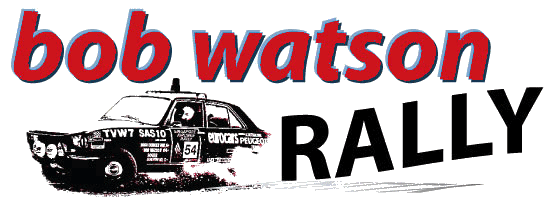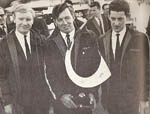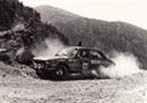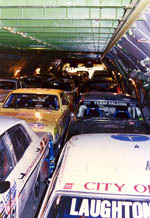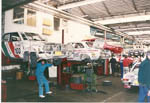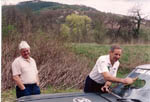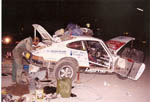Marathon Rallies
A short history of the London to Sydney Marathons
The term Marathon was first applied to motoring events in 1968 during a lunch with Sir Max Aitken of the London Daily Express and and two of his editorial executives, Jocelyn Stevens and Tommy Sopwith jr. They decided to create an event which their newspaper could sponsor, and which would serve to raise the country's spirits during a period of despondency in Britain caused by the devaluation of the pound. The event was a car rally from London to Sydney. Such an event would act as a showcase for British engineering, and would boost export sales in the countries through which it passed.
The initial UK£10,000 (AU$21,429) winner's prize offered by the Daily Express was soon supplemented by a £3,000 ($6,438) runners-up award and two £2,000 ($4,285) prizes for the third-placed team and for the highest-placed Australians, all of which were underwritten by the Daily Telegraph newspaper and its proprietor Sir Frank Packer, who was eager to promote the Antipodean leg of the race.
The concept of a rally from London to Sydney fired the imagination of the motoring public as well as the media. Car manufacturers world wide rushed to be involved, and the final entry of 98 cars reflected a who’s who of manufacturers and drivers. The event started at London’s Crystal Palace, and finished at Sydney’s Warwick Farm racecourse, travelling through Europe, Yugoslavia, Turkey, Iran and Afghanistan to Pakistan and finally Bombay in India, the end of the northern hemisphere leg.
Rally leader at Bombay was the exciting young English Ford driver Roger Clark, partnered by Swede Ove Andersson. Their Ford Cortina had established an early lead through the first genuinely treacherous leg from Sivas to Erzincan in Turkey, averaging almost 60 mph for the 170 mile stage and losing 11 minutes. Simo Lampinen's Ford Taunus was second and Lucien Bianchi's Citroen DS21 third.
The cars that made it to India were loaded on board the liner Chusan, which took them from Bombay to Fremantle in Western Australia. The weary crews and officials had a welcome break aboard the liner before embarking on a non stop dash across southern Australia to Sydney.
The final days of the London to Sydney Marathon across Australia fulfilled all of the expectations it had generated, and the story could not have been surpassed by a top fiction writer. Roger Clark, rally leader in a Ford Escort, damaged two engine valves in the dash across the Nullarbor Plain. The pace could be gauged by the fact that Lucien Bianchi in a Citroen averaged 97 miles per hour from Norseman to Port Augusta. Clark stopped for repairs, which dropped him back to third placing, and Simon Lampinen in a Ford Taunus took the lead, followed by Bianchi. In the rugged Flinders Ranges Evan Green in an Austin 1800, running fourth, stopped to help de-bog Andrew Cowan’s Hillman Hunter, then running fifth. This sporting action was destined to cost his team the rally wins.
Lampinen lost 8 minutes in Brachina Gorge with damaged rear suspension, and Bianchi took the lead. Then Green’s Austin, now running third, had an over tightened rear wheel bearing fail. The top order was changing almost hourly, and the Australian and world press was following the drama closely. The field raced across outback South Australia and into Victoria, and then north through the alpine region towards Sydney. Bianchi was leading Clark by two minutes, with German Staepalaere in a Ford Taunus third, Paddy Hopkirk in an Austin 1800 fourth and. Andrew Cowan fifth.
Although the rally was almost over, the drama was not. Clark’s rear axle failed in the NSW mountains and he had to buy one from a local’s car. Then the Taunus hit a gatepost, breaking a steering ball joint. Bianchi’s Citroen still led, but Cowan was now second, with Hopkirk third. The Australian Ford Falcons had been steadily moving up through the field with Ian Vaughan now up to fourth.
Then, only four miles from the Nowra control which was the finish of the rally competition, Bianchi’s Citroen, with Ogier driving, collided head on with a non competing car travelling against them on the rally road. The Citroen was destroyed, and Bianchi, who was in the passenger’s seat asleep, suffered leg and chest injuries. Hopkirk was first on the scene, and immediately returned to a radio point four miles back to summon help. Cowan’s Hillman Hunter took the lead, and was the surprised winner of the greatest motoring event of modern times.
1977
The 1977 Singapore Airlines London to Sydney Marathon was 30,000 kms in length, almost twice the distance of the 1968 event. It was, and still is, the longest rally ever held. Heading south through Europe and Yugoslavia to Athens in Greece, it then travelled via Turkey, Iran, Afghanistan and Pakistan to Madras (Chennai) in India. Here the cars were shipped to Penang and travelled south through the Malaysian peninsula to the sponsor’s base, Singapore.
The event covered 12,000 kms in Australia alone, reaching as far north as Wave Hill before going through the Flinders Ranges to Adelaide, then north through Broken Hill to Brisbane before the final run south to Sydney. The ship transporting the rally cars from Singapore to Fremantle arrived late, and the organisers gave the crews the choice of shortening the course or deleting rest breaks in order to reach the Sydney Opera House on schedule. The crews voted in favour of retaining the entire course, which meant rest breaks were cut to almost nothing.
While the original Marathon event proved a triumph for the Rootes Group and BMC, 1977's rerun belonged to Mercedes. The German marque claimed a 1–2 finish and had two other cars in the top eight, with Andrew Cowan in a 280E repeating his success of nine years previous, followed home by team-mate Tony Fowkes in a similar car. Paddy Hopkirk, this time driving a Citroën, took the final podium spot. The Peugeot 504 of Dunkerton/Watson/Bonhomme had moved from ninth at Fremantle to be third after a series of fastest times in conditions they knew, but third gear failed and the time taken to change the gearbox dropped them back to 5th, one point behind the fourth placegetter.
1993
Nick Brittan, a competitor in the original London to Sydney Marathon in a Lotus Cortina, established a company to organise modern endurance rallies starting with a 25th anniversary re-run of the 1968 Marathon in 1993. He persuaded 21 drivers who had competed in 1968 to return, including Andrew Cowan, Roger Clark and Ian Vaughan. Altogether 106 teams from 17 countries entered. Cowan drove his original 1968 winning Hillman Hunter, loaned to him by the Scottish Automobile Club museum and Vaughan drove his original Ford Falcon, while other competitors drove pre-1970 era cars. The entry fee was $A30,000, and the estimated cost of participating was put at $A90,000. Brittan stated “this is an event for seriously rich people”.
The 16,000 km rally had three major differences to the original. First, the political climate in the Middle East meant that countries such as Iraq and Afghanistan were now unavailable, although in Europe, Turkey and Australia much of the original route was retraced. Also, the old scheduled open road sections were replaced with more modern timed special stages for safety reasons.
Finally, with the need to limit the duration of the event there would be no voyage across the Indian Ocean to Australia, Brittan instead arranging for two Antonov An-124 cargo planes to take the vehicles from Turkey to India, and from India to Australia. These giants carried 50 cars each, stacked on specially made hydraulically operated platforms and packed in like sardines. The crews followed in dubious comfort on chartered Russian airline flights.
The special stages in Europe and Asia were generally on tarmac, and relatively short. However when the event reached Australia competitors were faced with gravel, sand, dust and stages up to 230 kms long. The Australian leg was laid out by Bob Watson, who followed the original course as much as possible within the restraints of needing to provide the crews with a bed each night- a contrast to the original event. Crews had to suffer the indignity of camping out midway across the Nullarbor at at Eucla, courtesy of the Australian Army, due to the lack of accommodation.
The winning driver was Francis Tuthill in a Porsche 911, ahead of the Ford Falcon GT of Ian Vaughan who finished third in 1968. Kenya's Mike Kirkland, a stalwart of the Safari Rally, took the final place on the podium in a Peugeot.
2000
A second rerun was organised in 2000 as a "Millennium celebration of the first epic event." Again, much of Asia was inaccessible for political reasons, with two Antonov airlifts again required. After crossing Europe and Turkey in the first fourteen days, the competitors would be loaded on to the Antonovs for the trip to northern Thailand, driving south through the country and into Malaysia for twelve days before being flown to Australia for the last eight days of the rally.
Of the 100 starters who left London 78 reached Sydney, with Stig Blomqvist and Ben Rainsford scoring victory ahead of Michèle Mouton in a Porsche 911, co-driven by 1993 winner Francis Tuthill. Rick Bates and Jenny Brittan in another 911 took third.
2004
The third rerun was a combination of modern Group N (showroom-class) cars, and pre-1977 classics, all limited to two wheel drive and a sub-two litre engine. New Zealand, in tandem with Lincolnshire, England race-preparation specialists Langworth Motorsport, scored a 1–2–3 podium clean sweep with three Kiwi-piloted Honda Integras; overall winners Joe McAndrew and Murray Cole, runners-up Mike Montgomery and Roy Wilson, and Shane Murland and John Benton in third. The highest-placed classic car was a Ford Escort RS1600 driven by Britain's Anthony Ward and Mark Solloway, which finished sixth overall.
There have been numerous other long distance events run, including two rallies run in conjunction with the World Cup soccer contest, and others across Africa and America, but Sir Max Aitken’s original concept remains the most exciting of all.
Postscript to the 1968 Marathon
The details of the unfortunate ending of the 1968 London to Sydney Marathon have finally surfaced, some 51 years on. Issue 20 (October to December 2009) of the magazine Mini Experience contains an article written by the passenger in the Mini that collided head on with Marathon leader Lucien Bianchi’s Citroen, costing the Frenchman the victory of a lifetime.
The article is very frank and open, and dispels the many rumours surrounding the unfortunate collision. The occupants of the Mini were not drunk, and were not off duty policemen. The article contains some graphic photos of the accident, and it is remarkable that the two occupants of the Mini survived considering the damage to the car.
Well worth the read.
www.miniexperience.com.au
